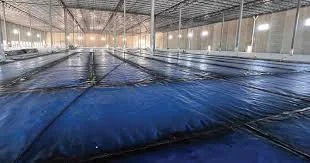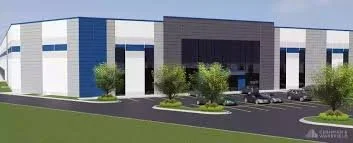New York City Metropolitan area is one of the busiest corridors for tourism, commercial flights and cargo coming into the US. Investment into distribution centers in the area have been needed as people shopping online has continued to grow. Bridge Point 15E is an industrial property that is helping in Northern New Jersey’s industrial expansion having been certified for LEED Gold for BD+C: Core and Shell. Located in Newark, NJ Bridge Point 15E is a 211,388 square foot industrial property that is advantageously located half a mile from the New Jersey Turnpike, three miles from Newark International Airport and other New Jersey Port Facilities that is looking to make the most of local shipping and receiving routes.
One interesting aspect of this building is the installation of EPRO’s Geo-Seal EV40s that is a sheet membrane installed to address brownfield conditions in the space to protect the health and safety of not only the building itself to make it more sustainable for the land that it is built on to protect the land. Many of the industrial sites in Newark and around New York City as a whole have been heavily built on and have been subject to large scale pollution for decades.
Within the LEED Certification many people don’t often think of distribution facilities as having green building certifications or initiatives as we often don’t directly engage with these buildings. Many buildings are looking to invest in initiatives as the drive to reduce overall carbon footprints in shipping has become increasingly important to many companies in their Scope 3 emissions reports. The category within the LEED Scorecard that was taken most seriously was Location and Transportation category receiving 10 out of 20 possible points given that it is a distribution center and was built on previously developed land. Within the credits earned for this facility where for sensitive land protection, high priority site, surrounding density and diverse uses and green vehicles. These points for a distribution center are important for helping to reduce overall carbon footprints.
Water efficiency was also an area that the building scored highly in receiving 10 out of 11 possible points only missing one for water metering. Seeing as the building is a distribution center most of the water metering would be in bathrooms and an employee lounge. One interesting aspect about the credit categories is seeing what is important to the project as priorities differ deepening on the needs of the project. One interesting credit that was achieved is for cooling tower water use on the building along with indoor and outdoor water use reduction. Interestingly one category that the project really lagged in was the Indoor Environmental Quality Category only achieving 2 out of a possible 10 points. The two points where achieved for enhanced indoor air quality (IAQ) strategies and contribution IAQ management plan. Points where missed for daylight and quality views, but given that it is a distortion center where the bulk of the operations of the building are for physical products and not necessarily people it is not shocking that these where not priorities in the project.
Innovation & Regional Priority categories while smaller categories points wise were able to achieve 4 out of 6 and 3 out of 4 points respectively. Point 15E was able to achieve 3 out of 5 points in the innovative category alongside a point for having a LEED AP on staff. Within the regional priority credits the project achieved points for sensitive land protection, surrounding density and diverse uses and indoor water use reduction. Point 15E shows the future of distribution centers and how green buildings are important even for buildings that we do not interact with. Having sustainability throughout the supply and shipping chain is important for all of us to help reduce our overall global footprints.
Interested in learning more?
EPRO Link: https://www.eproinc.com/case-studies/bridge-point-15e
USGBC Scorecard: https://www.usgbc.org/projects/bridge-point-15-e

